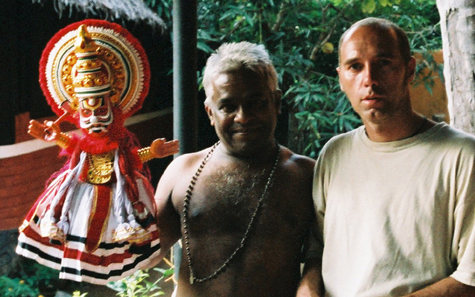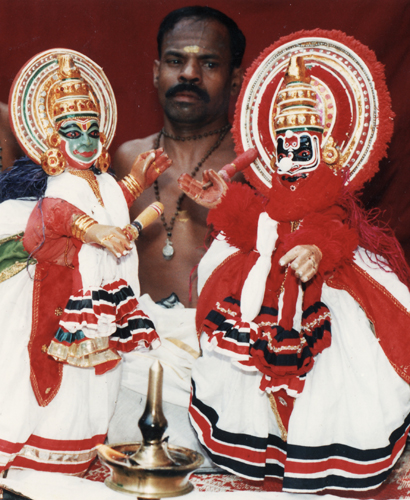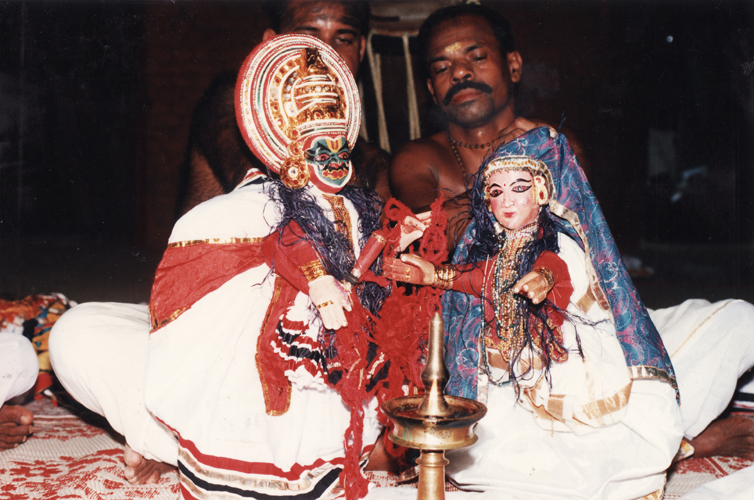

History
Pavakathakali is the name given to traditional hand puppets played in Kerala which are present in the Palghat district and some surrounding villages. In one of Paruthippully, some families are factors Pavakathakali for many generations. Pavakathakali name appears in the 18th century. Pava means "puppet or doll" and Kathakali "Play a story." When the Kathakali, a famous classical dance drama of Kerala came into the district of Palghat, it has naturally influenced the game of hand puppets that existed here. Puppeteers are beginning to dress their dolls with costumes similar to Kathakali and adopt the themes directory called Attakatha-s for their performances. The Kathakali eventually evolve into an art form called Ramanattam, from south of Travancore, to the second part of the 17th century through the efforts of Raja kottarakarra. Then he won the North of Kerala in the late 17th century and it soon spread and flourished under the patronage of Raja Vettathunadu. The evidence shows that long before the Kathakali, the hand puppets were very popular in villages in the district of Palghat. A Paruthippully in a house belonging to a family of puppeteers, a figurine was discovered. Archaeologists say which dates from more than 400 years. Specifically, this beautiful doll, carved wood, not the aesthetics and distinct forms of Kathakali and it definitely shows that the interplay of Pavakathakali existed long before the appearance thereof. The ornaments of the headdress, are different from those found on ancient sculptures in Kerala. She has elongated earlobes, which made reference to the pictorial representations of Buddha. But another puppet named by the 18th century, closely resembles the character called "Pasha" of Kathakali, in exception of the white edge feature shaped beard called Chutty.
Puppets and Handling
Their sizes vary between 30 and 60 cm. The head and arms are delicately carved in wood, joined together with a piece of cloth and hung in a small cloth bag. The puppets are really beautiful, with their different makeup and colorful, with the costumes and hairstyles of small pieces of gold ornaments, coral, copper and peacock feathers. The handler inserts his hand into the bag forming the body of the puppet, then moves his head and hands of the doll with her fingers. Hands are manipulated with the thumb and middle finger while the index directs the head.
For performance Pavakathakali no stage equipment
is necessary. Performances take place in houses or places with appropriate
cultural performances. Musical instruments are those used in Kathakali.
There is the Chenda, the Changila the Ilathalam and Shankha. The minimum
for artists is a good representation of 6 people. When the troupe of puppeteers
arrived at the place set, an oil lamp copper, "Nilavilaku" used
in Kerala for the sacred and religious, is on the eastern corridor of the
house. The puppeteers stand still and sing a hymn praying to the gods. Then
in response to an invitation from their hosts, they begin the representation
that will last 1 or 2 hours. But in some occasions like Tiruvatira or Sivaratri
it may continue throughout the night.
In this case, artists are paid from hand to hand (Arangua panam) "money
scene" In return the head of the troupe offers a dhoti with embroidered
householder. The crowd also gave money and gifts to the puppeteers.
The episode played by Pavakathakali come from the Mahabharata and include the following scenes: Saugandhikam Kalyana, Uttarasvayamvaram and Duryodhana Vadham. Episodes of Ramayana and Tamil stories were played by the past. There are 30 years Pavakathakali was alive and very appreciated by the villagers. The greatest artists, since deceased, are Andivelan, Karappan, Raman, Chinnan, Thengara, Veeran and Chammu. The last death 18 years ago, was a very big and very important puppeteer. After their deaths, the Pavakathakali has declined dramatically.
Puppeteers
The handlers are called Andi Pavakathakali-Pandaram and belong to several families in the village of Paruthippully. Telugu, their language suggests that their ancestors were immigrants from Andhra Pradesh and belonged to the Guru Veera Saiva community based in Palghat, centuries ago. Now they speak a dialect where the Malayalam sometimes mixed with Tegulu. Currently, they live scattered in some 30 villages around Palghat but still form a united group solidarity. A Paruthippully, only 3 or 4 families Andi Pandaram 100, practice the art of Pavakathakali. Others do not know the practice. The Andi-Pandaram are great devotees worship the Lord Subramania and are known for their knowledge on all aspects of this cult. In fact, they earn their living by, for believers, the ceremonies of the "pooja" in honor of Subramania and pilgrimages to the temples of Palani, where they are invested with rights and privileges. Their assistance is sought and when a family wishes to organize the ritual they willingly accept those invitations that have places mainly between December and February. They have all the hardware ceremony as early idol Kavadi (a bow on a wooden frame decorated with peacock feathers worn by believers) and many other objects carried in the house which will host it. They go to the family while celebrating Kavadi then arrived at the place of the ceremony, the children take home the idol, put it on their shoulders and rotate 3 times on themselves while Andi Pandaram blow in conch knocking on gongs and singing hymns appropriate. At the end, family members provide a sumptuous feast for Andi Pandaram. When there is no worship to celebrate, they visit the villages with their puppets.


In 1981 a serious work is being undertaken to revive this art, thanks to Ms kamaladevi Chattopadhyay, chairman of the Sangeet Natak Academy. She confided to the great puppeteers Chammu and G. Come for a comprehensive study on conditions at that time of Pava Kathakali. Dismayed, they learn there is no more than 3 manipulators alive but unable to assume full representation. From there, recovering old puppets and collect as much information and detail as possible about the art. Then they select 6 villagers and 2 years for their intensely teach music, manufacture and manipulation of puppets.
The Academy granted a scholarship to these students. Following this training, part Kalyana Saugandhikam was again played in its original form. The government and the department of culture were generous enough and attributed funding for this new boom. With this support, new puppets were made and parts Uttarasvayamvaram, Duryodhana Vadham, Dakshayagam and Balivadham were created.
In 1984 the troupe Pavakathakali is invited to attend the 11th Festival of puppets in Poland.
In 1986 the carnival of Japan.
1987 is the year of the consecration, the troupe produces 4 to 15 November in Geneva, Locarno, Lausanne, Basel and Zurich.
From 19 to 29 November in Amsterdam at the International Puppet Festival in Holland and 1 to 6 December in the House of World Cultures in Paris.
Since the art is protected and developed by G. Venu, director and founder of the center Natana Kairali, real laboratory research, protections for all the arts of Kerala. G. Venu is Kathakali dancer, puppeteer Pavakathakali and Tholpavakoothu professor historian. It organizes and participates in several puppet festivals, dances, India and worldwide. He wrote many books on Kathakali, the Pavakathakali the Tholpavakoothu and other art forms.




Gopal Venu is well known for
his contribution to performing arts of Kerala in India - as a person responsible
for the rejuvenation of several rare traditional art forms and as a research
scholar.
Some of his major published works include "Into the World of Kutiyattam
with the Legendary Ammannur Madhava Chakyar", "Mudras in Kathakali",
"Production of a play in Kutiyattam", "Mohiniyattam -The last
dance" and "Puppetry and lesser known dance traditions of Kerala".
G.Venu was responsible for the formation of the institution Natanakairali (research and performing centre for traditional arts) and Ammannur Chachu Chakyar Smaraka Gurukulam (a training center for Kutiyattam), both located at Irinjalakuda
G. Venu has also received several honours including Kerala Sahitya Academy Award, Homi Baba Fellowship, Indira Gandhi Memorial Trust Fellowship and Senior Fellowship from Department of Culture, Government of India.
Natanakairali at Irinjalakuda (Thrissur District) is the focal point of many artistic activities, both in the traditional and contemporary spheres; the workshops, performances and festivals hosted by the centre have highlighted the relevance of lesser known arts like Kutiyattam (Sanskrit drama), Pavakathakali and Tolpavakuttu (two forms of puppetry) for our times.
Natanakairali has published
a number of books in Malayalam and English on various subjects pertaining
to the artistic traditions of Kerala. Numerous articles have been published
to share the outcome of over two years research with a broader public, notably
students and fellow artistes all over India.
On the strenght of rigorous training and the upholding of uncompromising standards of performances, Natanakairali, under the guidance of its founder-director G. Venu, has become an internationally renowned centre of performing arts.
Performances by the artists of the centre have been the among the highlights featured at theatres from Taiwan to Stockholm.
The revival of traditional puppetry
(Pavakathakali glove puppets and Tolpavakuttu leather puppets for shadow plays),
which was on the verge of extinction just two decades ago, has been so successful
that replicas have been acquired by prestigious institutions and collections
abroad (e.g. Tropenmuseum Amsterdam).


